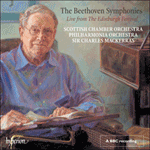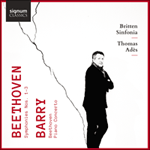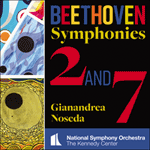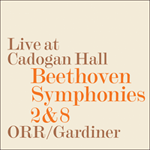
Welcome to Hyperion Records, a British classical label devoted to presenting high-quality recordings of music of all styles and from all periods from the twelfth century to the twenty-first.
Hyperion offers both CDs, and downloads in a number of formats. The site is also available in several languages.
Please use the dropdown buttons to set your preferred options, or use the checkbox to accept the defaults.

One remarkable aspect of the work is the sheer scale of the coda in its outer movements. In the opening Allegro con brio, the coda features extremes of dynamic contrasts, with the violins and violas on their own twice quietly giving out a fragment of the main theme, only to be dismissed angrily by a fortissimo outburst from the full orchestra. After a solitary oboe and bassoon have met with the same treatment, the fortissimo is maintained solidly for more than thirty bars, while the basses stride chromatically upwards in long notes as though wearing seven-league boots. Finally the lower strings launch into a ‘running’ figure while the violins indulge in spectacular leaps, and trumpets and drums add spiky off-beat accents. It is an assault-course of a kind that no composer had attempted before on this scale.
Following the exuberance of the opening movement, the slow movement provides a welcome aura of serenity. This being the symphony it is, however, the calm atmosphere is by no means unbroken, and the latter half of its central section incorporates a fiercely intense development of the opening theme, before order is restored with the reprise of the theme itself.
The scherzo makes its joke out of fooling the listener as to where its tutti explosions are going to occur; while the scarcely less gruff trio, with its flowing, wind-orientated scoring, seems to look forward across the years to the parallel section of the ninth symphony. Gruffness is the keynote, too, of the finale, with its nervously abrupt main theme. Mindful of the theme’s erratic behaviour, Beethoven is careful to give the remainder of his material a much more regular cast. Despite a brief return of the main theme in the home key roughly a quarter of the way through its course, the piece is not a rondo: that return indicates instead a structural shortcut—a hint at a complete repeat of the sonata-form exposition, after which Beethoven proceeds directly to the development section, with a plunge into the minor. Beethoven invoked a similar deliberate deception in the finale of his eighth symphony, and the first movement of the ninth, and the procedure was one that exerted an influence on a host of composers to come, including Mendelssohn, Schumann, Brahms and Dvorák.
from notes by Misha Donat © 2007
Cette œuvre vaut surtout par l’envergure même de la coda dans ses mouvements extrêmes. Celle de l’Allegro con brio d’ouverture présente de très forts contrastes dynamiques, les violons et les altos exposant par deux fois, et tout seuls, un fragment du thème principal, mais pour être aussitôt rageusement congédiés par une explosion fortissimo au grand orchestre. Un hautbois solitaire et un basson subissent le même sort, après quoi le fortissimo est fermement maintenu pendant plus de trente mesures, tandis que les contrebasses, comme chaussées de bottes de sept lieues, progressent chromatiquement à grandes foulées ascendantes, en notes longues. Pour finir, les cordes inférieures se lancent dans une figure «allante», pendant que les violons se livrent à de spectaculaires sauts, et que les trompettes et les tambours saupoudrent les temps faibles d’accords épicés. Voilà un parcours du combattant comme aucun compositeur n’en avait encore tenté à pareille échelle.
Le mouvement lent offre une sérénité bienvenue après l’exubérance du mouvement d’ouverture. Toutefois, cette symphonie étant ce qu’elle est, la paix est loin d’être acquise et la seconde moitié de la section centrale inclut un développement farouchement intense du thème initial, avant que l’ordre ne revienne avec la reprise du thème même.
Le scherzo plaisante en bernant l’auditeur sur les endroits où vont exploser les tutti; à peine moins bourru, avec son écriture fluide tournée vers les vents, le trio semble se projeter vers son pendant dans la neuvième symphonie. Le finale est également placé sous le signe de la brusquerie, avec son thème principal d’une soudaineté nerveuse. Attentif au comportement erratique du thème, Beethoven prend soin de conférer au reste de son matériau une tournure bien plus régulière. Le thème principal a beau revenir brièvement dans la tonalité principale, vers le quart du parcours, cette pièce n’est pas un rondeau et ce retour indique plutôt un raccourci structurel—une allusion à une complète reprise de l’exposition de forme sonate, au terme de laquelle Beethoven embraye sur la section de développement, avec une plongée en mineur. Le compositeur recourra au même stratagème dans ses huitième et neuvième symphonies (respectivement dans le finale et dans le premier mouvement); ce procédé sera d’ailleurs l’un de ceux qui influenceront une foule de musiciens comme Mendelssohn, Schumann, Brahms et Dvorák.
extrait des notes rédigées par Misha Donat © 2007
Français: Hypérion
Ein bemerkenswerter Aspekt des Werkes ist das schiere Ausmaß der Koda in den Außensätzen. In dem einleitenden Allegro con brio weist die Koda extreme dynamische Kontraste auf. Zweimal deuten die Violinen und Violas allein leise ein Fragment des Hauptthemas an, werden aber jedes Mal durch einen Ausbruch des gesamten Orchesters im fortissimo barsch wieder zurückgewiesen. Nachdem einer einsamen Oboe und einem Fagott die gleiche Behandlung widerfahren ist, behauptet sich das fortissimo beharrlich noch mehr als 30 Takte lang, während die Kontrabässe chromatisch in langen Noten aufwärts steigen, als stampfe ein Riese daher. Schließlich beginnen die Streicher mit einer „laufenden“ Geste, während sich die Violinen spektakuläre Sprünge genehmigen und die Trompeten und Pauken spitze Akzente gegen den Grundschlag hinzufügen. Das ist ein Hindernissparcour von einer Art, die noch kein Komponist zuvor in dieser Größenordnung versucht hatte.
Nach dem Überschwang des einleitenden Satzes verbreitet der langsame Satz eine willkommene ausgeglichene Atmosphäre. Dem Charakter dieser Sinfonie getreu bleibt diese ruhige Atmosphäre aber unbedingt nicht unangefochten, und die zweite Hälfte des Mittelteils enthält eine extrem intensive Durchführung des Anfangsthemas. Mit der darauf folgenden Wiederholung eben jenes Themas wird die Ordnung jedoch wiederhergestellt.
Der A-Teil des Scherzos spielt mit dem Hörer einen Scherz, indem er ihm über den Einsatz der Tuttiausbrüche im Ungewissen lässt, während das kaum weniger schroffe Trio mit seinen fließenden Linien und seiner Neigung zu Holzbläsern einige Jahre voraus auf den entsprechenden Abschnitt aus der 9. Sinfonie zu schauen scheint. Schroffheit ist auch das treffende Wort zur Beschreibung des Schlusssatzes mit seinem nervös stockenden Hauptthema. Sich des sprunghaften Verhaltens des Themas bewusst verleiht Beethoven dem restliche Material sorgfältig einen viel regelmäßigeren Zuschnitt. Trotz der kurzen Rückkehr des Hauptthemas zur Grundtonart nach ungefähr einem Viertel des Verlaufs ist das Stück kein Rondo: Diese Rückkehr stellt lediglich eine strukturelle Abkürzung dar—die Andeutung einer in der Sonatenform bis dahin üblichen vollständigen Wiederholung der Exposition. Beethoven springt dann aber direkt zum im tiefen Moll gehaltenen Durchführungsabschnitt über. Ein ähnliches Täuschungsmanöver führte Beethoven im Schlusssatz seiner 8. sowie im ersten Satz seiner 9. Sinfonie durch, und auch eine Reihe späterer Komponisten wie zum Beispiel Mendelssohn, Schumann, Brahms und Dvorák schauten sich diesen Kunstgriff ab.
aus dem Begleittext von Misha Donat © 2007
Deutsch: Elke Hockings
 Beethoven: Symphonies Beethoven: Symphonies‘Hyperion's set is that early evening Beethoven cycle caught in recordings of remarkable intimacy and focus … it is a set I would happily put int ... ‘So magnificently exhilharating an account’ (BBC Music Magazine)» More |
 Beethoven: Symphonies Nos 1, 2 & 3 Beethoven: Symphonies Nos 1, 2 & 3These much-anticipated recordings were made during the Britten Sinfonia's three-year Beethoven symphony project. Conductor Thomas Adès interleaves Beethoven’s masterworks with the audacious and sometimes explosive music of the wonderfully idiosync ...» More |
 Beethoven: Symphonies Nos 2 & 7 Beethoven: Symphonies Nos 2 & 7Beethoven's muscular second symphony, completed early in 1802, is coupled with No 7 of a decade later, the finale of which was famously described by Wagner as representing ‘the apotheosis of the dance’. Performances are everything we have come to ...» More |
 Beethoven: Symphonies Nos 2 & 8 Beethoven: Symphonies Nos 2 & 8The Orchestre Révolutionnaire et Romantique and Sir John Eliot Gardiner revisit some favourite repertoire—twenty years after their acclaimed Beethoven symphonies recordings for Deutsche Grammophon.» More |

